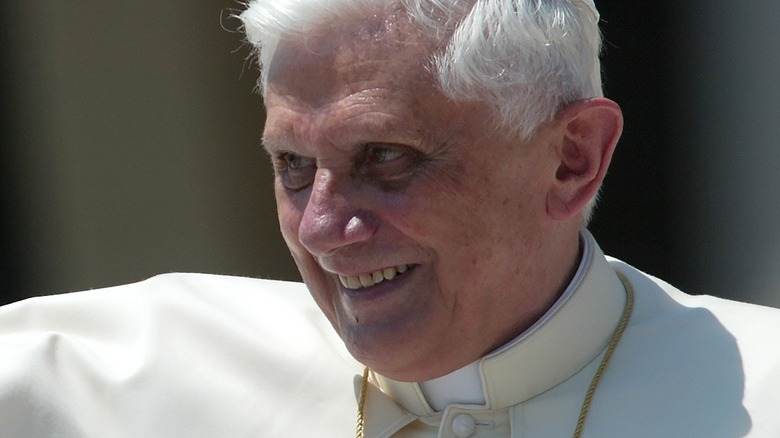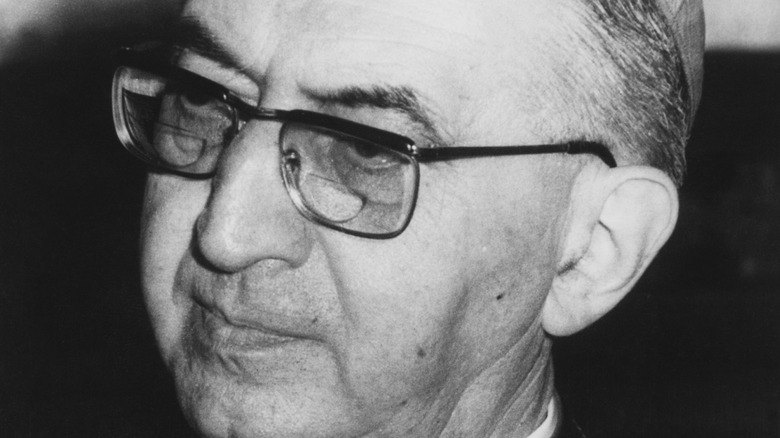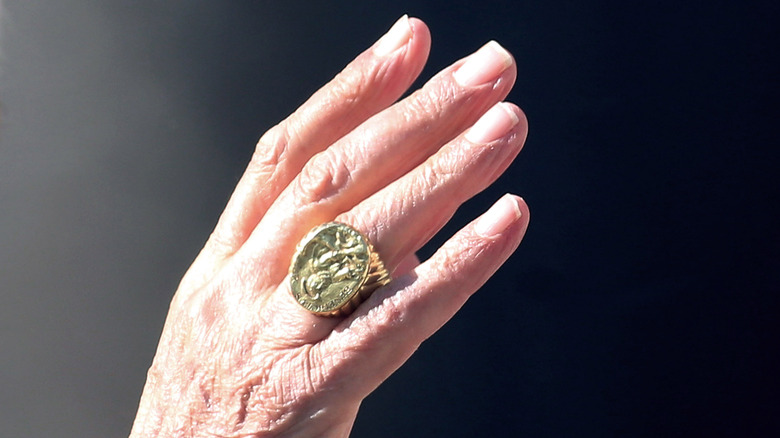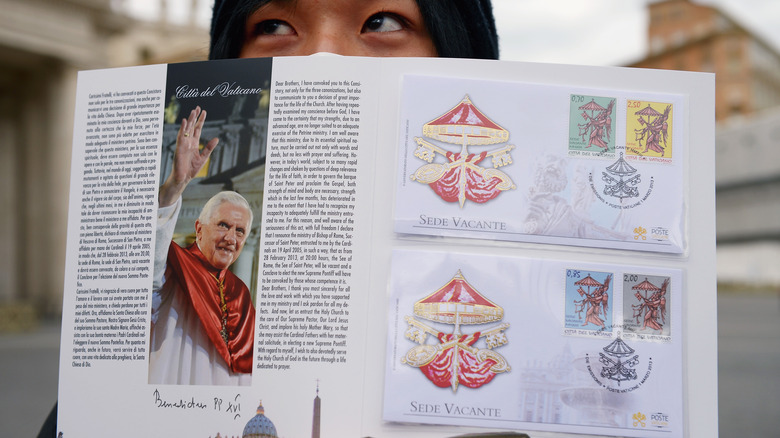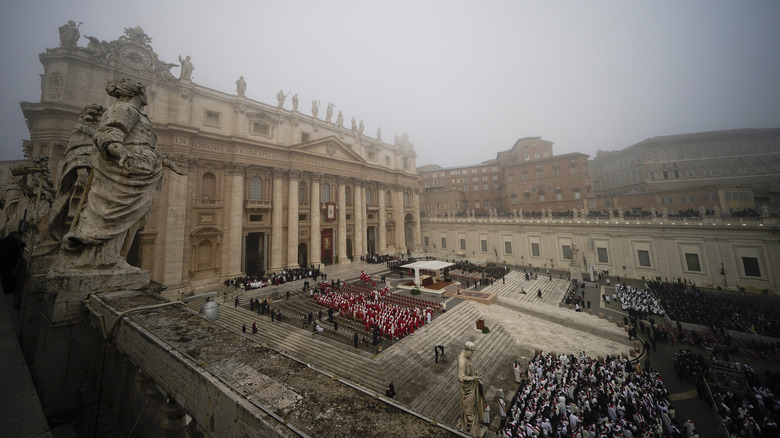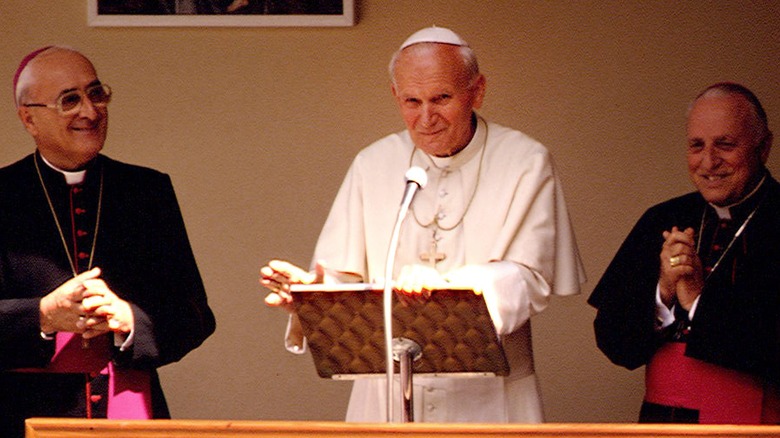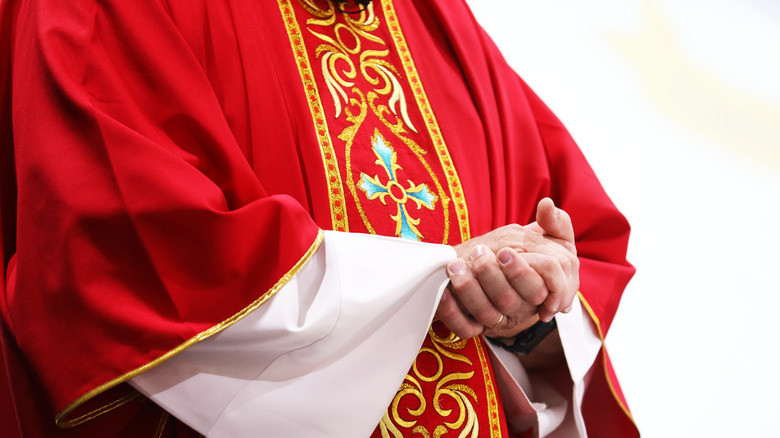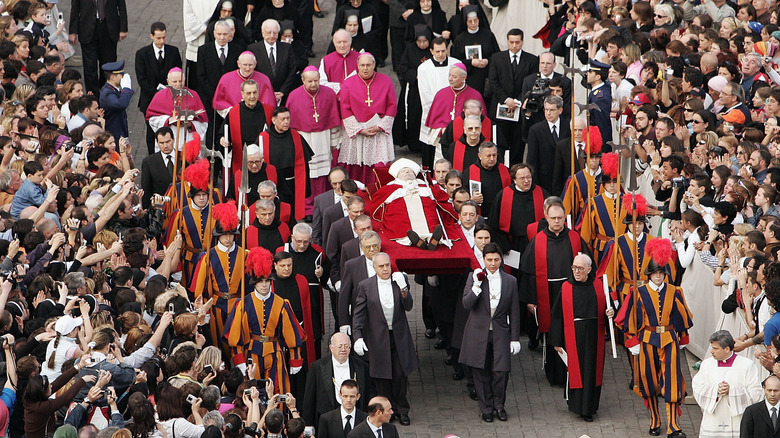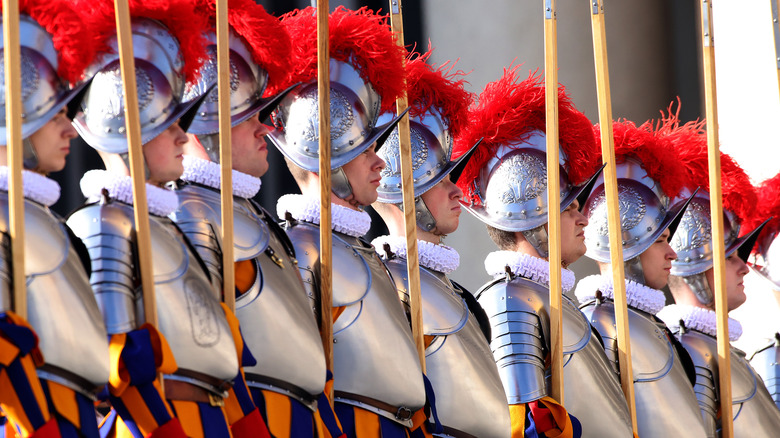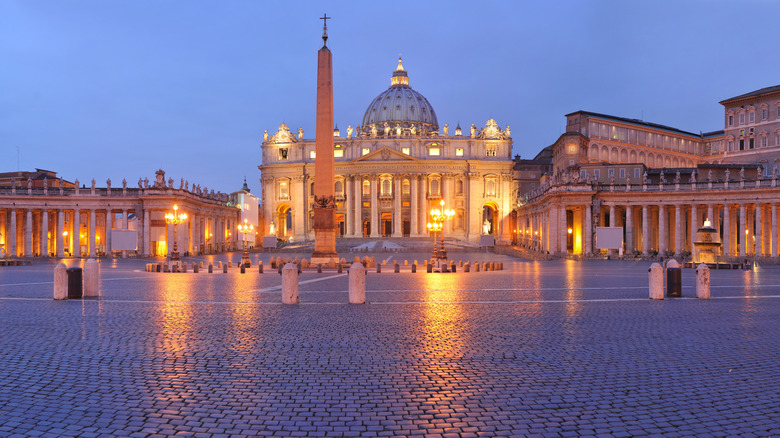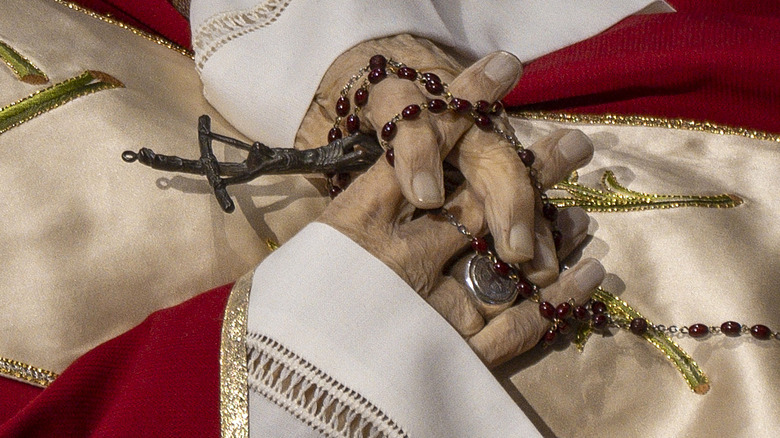What Funerals For Popes Are Like
You'll not hear the pope call himself a king. But the bishop of Rome is an elected monarch, the sovereign ruler of Vatican City. His worldly domains have shrunk considerably since the days of the papal states: According to History, Vatican City is 0.2 square miles in size and around 800 in population. But limits on temporal authority rarely stop a monarchy from projecting majesty, as even a casual look at St. Peter's Square would suggest.
Far more significant than his limited powers as an earthly sovereign is the pope's role as head of the Roman Catholic Church, the house of God for over a billion adherents to the faith. Popes issue teachings and edicts and are directly involved in the church's government, in the name of spreading the Gospel (per the National Catholic Register). The leadership style and character of an individual pope carry significant weight for the church, and the enduring influence of Catholicism across the world — even in the 21st century — gives the pope an international voice and authority unmatched by other religious leaders (per the Council on Foreign Relations).
Therefore, the death of a pope is, for many, as somber as the death of anyone who calls themselves queen or king. And centuries of tradition (per CBS News) have shaped the way a pope is put to rest. But the death of Benedict XVI, a former pope who lived during the ongoing reign of his successor, has challenged those traditions.
His chamberlain officially declares his death
Popes have doctors and access to modern medicine, and they manage their health much the same as anyone. For example, Pope Francis's health has been a subject in the news for some years: According to CNN, in November 2022, a team of specialists was called in for the pontiff's ongoing knee trouble. But when it comes to the death of the bishop of Rome, ceremony must be satisfied as well as the physician.
The man who must observe this ceremony and formally proclaim the pope's death is called the camerlengo. California State University Northridge describes the camerlengo as a papal chamberlain, with significant authority over the Vatican court. By tradition, the camerlengo must identify the pope's body, confirm his death before various church officials, and give absolution. There are widespread claims that the ceremony demands the camerlengo call the pope's name three times and tap his head with a silver hammer, but according to CSUN, the business with the hammer is likely a myth, and there is no fixed number or even requirement that the name needs to be called.
Per NPR, after satisfying custom, the camerlengo alerts the vicar of Rome of the pope's death, that the vicar might spread the word throughout the city (another bit of ceremony, since in the modern media age, the public will have heard by then). Until a new pope is chosen, the camerlengo also becomes the temporal regent of Vatican City (per the National Catholic Register).
The pope's ring is destroyed
While Pope Francis has reportedly discouraged Catholics from observing it, a tradition dating back to medieval times stipulates that members of the church who meet a bishop — and the pope is the bishop of Rome — must kiss his ring (per the Catholic Herald). In the pope's case, that might mean kissing the Ring of the Fisherman, part of the papal regalia and the center of a ritual followed after the death of the pontiff.
The Fisherman's Ring is so named due to the pope's claimed succession from Saint Peter, a fisherman of Galilee (per Britannica). It isn't the only ring associated with the papacy: Pope Francis usually goes without it, except when about particular ceremonies, but it is distinguished by being designed for each pope. Up until the 1800s, the unique appearance of each ring let popes use it as a seal on their private correspondence. This made its destruction after the pope's death a necessary precaution against forgeries (per The Baltimore Sun).
Stamps replaced wax seals after 1842, but as an individualized symbol of a given pope's reign, destroying his fisherman's ring after his death is still a way to mark the end of his time. It's customary for the ring to be smashed by a silver hammer, according to the BBC, but this isn't always observed. When Benedict XVI retired in 2013, the seal of his ring was etched out, but the ring itself remained intact.
Sede vacante
Upon the death of a pope, the Vatican enters a period known as sede vacante (an empty throne) and remains so until a new pope is elected. Sede vacante triggers several procedures, most of which were still observed when Pope Benedict XVI retired in 2013. At that time, the Catholic News Agency described how the absence of a pope activates the head of the Apostolic Chamber, an otherwise dormant office, to seal off the papal apartments with tape, ribbons, and wax. According to The Baltimore Sun, the papal palace is further sealed by chains, and flags and coins are positioned and minted to signal that sede vacante has begun.
Sealing off the papal apartments was traditionally a precaution against looting — per NPR, cardinals and commoners alike would often help themselves to whatever they found. These days, securing the pope's quarters allows his private documents and correspondence to be managed as desired. The chains on the palace are more of a symbolic gesture — the death of a pope weighs over all else. The specially minted coins are sold to cover funeral expenses.
Sede vacante can also be referred to as the interregnum, the period between two popes (per The Washington Post), and the College of Cardinals is summoned at this time by the Vatican. Within 15 to 20 days after the pope's death, the College must begin the conclave, the election of a new pope. At least one more than a two-thirds vote is needed to win the papacy.
Nine days of mourning are observed
The prescribed period of mourning for a pope is nine days and is known as the novendial, per the Belfast Telegraph. According to CBS News, the length of time observed goes back to the Roman period, and according to the Vatican news agency Agenzia Fides, it is marked by nine requiem Masses. Being a figure of international importance, the mourning of a pope takes on a global character. The Vatican is quick to issue a formal notice to the College of Cardinals and various world leaders that the pontiff is dead. According to The Baltimore Sun, these missives are often curt, just one or two sentences summoning the parties to Rome.
The pope's body traditionally lies in state for three days after death, so that visitors might pay their last respects before the funeral. After an initial period in the Clementine Hall of the Apostolic Palace, the body is open to public viewing in the Clementine Chapel of St. Peter's Basilica. In the past, popes have been embalmed before lying in state, but this was not observed when Pope John Paul II died, according to the Belfast Telegraph.
Popes have great significance to many of the world's Catholics, and their period of lying in state can attract many visitors. CBS News reported that 750,000 people came to see Pope John Paul I in 1978, while the Belfast Telegraph estimated millions came for John Paul II.
The funeral should happen 4 to 6 days after the pope's death
After a pope is declared dead, the funeral is held four to six days later. That isn't a matter of convention or tradition; it's in writing. In 1996, Pope John Paul II issued "Universi Dominici gregis," an apostolic constitution. Apostolic constitutions are often issued as papal bulls, documents in the pope's name with his seal, and represent the most significant form of legislation a pope can advance on matters of doctrine and church government (per the library of Saint Paul University).
Universi Dominici gregis (via the Vatican website) is primarily concerned with the governance of the church during sede vacante, the time when there is no pope. John Paul II eliminated alternatives to the secret ballot by which the College of Cardinals elects a new pope, specified what powers the college does and does not hold during sede vacante, and tightened security requirements around the conclave. But the document also attended to matters concerning the death of the pope.
In Chapter II, subtitled "The congregations of the cardinals in preparation for the election of the supreme pontiff," John Paul II put down the timing for a pope's funeral. He instructs the college to undertake all preparations needed for a service four to six days out from death, with exceptions allowed for what he called "special reasons." What those might be, was left undefined.
Red for mourning
The priesthood of the Catholic Church is easily spotted by its unique wardrobe. That wardrobe is accentuated throughout the year by various colors, and ranks within the priesthood are similarly marked. The use of special clothing and hues within Catholicism was developed over a long time; the earliest priests probably dressed no differently than anyone else, and distinguishing features in wardrobes varied as they appeared. The Terra Sancta Museum explains that it was only in the 12th century that the church codified which colors would be used for which occasions.
The color guide offered by the Terra Sancta Museum puts down black for mourning and penitence, and red for love, martyrdom, fire, and blood. And yet, when a pope dies, he goes to his final resting place in red vestments. According to the Liturgical Arts Journal, this is likely a funeral tradition from eastern nations and the Byzantine Empire imported to Rome. Red took on associations with St. Peter, in whose steps the popes claim to follow (per Britannica).
ABC News reported after Pope John Paul II's death that red also marks the pope as a witness of the faith. It's a color shared with the cardinals of the church, who elect the pope from among their number and act as his advisors. And a more practical use for red, or any color, in ceremonies is that it makes the key figures easier to see.
Popes have a three-part funeral
Papal funerals are conducted according to the instructions set down in the manual "Ordo Exsequiarum Romani Pontificis," which was first made public after the death of John Paul II (per The New York Times). It divides the pope's funeral into three stages, each observed at a different location and before different assemblies. Each sees a Mass celebrated — the same Mass as for any deceased Catholic.
The first stage of the funeral sees a Mass celebrated over the pope as he lies on his bier. The second stage, the most elaborate of the three, has taken place outside in St. Peter's Square since the death of Pope Paul VI, according to the LA Times (via California State University Northridge), which published a visual guide to the service in conjunction with the funeral of Pope John Paul II. The Mass is celebrated before St. Peter's Basilica, and this stage can last up to three hours, as psalms, silences, and multiple languages are accommodated. A papal funeral can attract millions, within Vatican City itself and across myriad viewing platforms via modern technology.
The last stage sees the pope taken to his final resting place by a small number of attendants, who deliver a final prayer of commendation. CSUN's guide reported that John Paul II and Paul VI are the only popes to have been buried. Most of their predecessors, and John Paul I between them, were entombed in sarcophagi below St. Peter's Basilica.
It's a major security operation
Funerals aren't a place many would expect to see heavy security. But public figures attract attention even in death, and public figures with as global a reach as the pope do so at a massive scale. With up to millions of Catholics and scores of officials from world governments descending upon Rome to mark a pontiff's passing, a papal funeral becomes a major security operation for Italian authorities.
According to Inside Edition (via YouTube), Vatican stipulations forbid any but its own security from carrying firearms within the city, complicating arrangements for the safety of visiting heads of state. During the funeral of Pope John Paul II, the American presidential delegation included then-President George W. Bush, his father George Bush, Bill Clinton, Secretary of State Condoleezza Rice, and first lady Laura Bush, with their attendant Secret Service agents. Former agent Joe Petro speculated that a quiet agreement would be reached between them and the Vatican to get around the rules.
Besides securing VIPs, another logistical issue for Rome is accommodating the sheer numbers. Inside Edition also reported that Italian officials were willing to close the city to visitors if it reached capacity during John Paul II's funeral. Elaborate tent cities and video screens were set up outside Rome to provide housing to visitors unable to get hotel rooms, and warehouses were reappropriated to the same end.
Most are buried at St. Peter's Basilica
Pope Benedict XVI was buried on January 5, 2023. He was laid to rest as planned in St. Peter's Basilica, as the Catholic News Agency describes. He'll be in good company: The basilica has been the resting place of choice for pontiffs for centuries. According to Britannica, the building dates back to 1506, when construction began under Pope Julius II, following earlier plans by Pope Nicholas V to replace an older structure. Completed in 1615, it was the largest Christian church in the world until 1989 and remains the holding place for artwork and relics. It is also regularly used for ceremonies by the pope in life.
It's estimated that 90 popes are buried in either the basilica or its underground tombs. Tradition holds that St. Peter himself, the first pope, was buried there, and among the relics kept in the basilica are bone fragments said to be his. It's worth noting that this claim has faced serious challenges from archeologists and the Jesuit order: Per The Guardian, the bones were only found in the 20th century, in a shoe box during excavation. But the Vatican insists that it's satisfied as to their identity.
The majority of popes buried at the basilica lie in sarcophagi. Two exceptions include Paul VI and John Paul II; per the LA Times (via California State University Northridge), they went into the tombs, but were buried. John Paul II was later moved within the church itself after his beatification.
Benedict XVI's funeral broke from tradition
Pope emeritus Benedict XVI's funeral took place on January 5, 2023, as reported by ABC News. In life, Benedict broke 600 years of precedent by resigning from the papacy (per USA Today). His final years were spent away from the public eye as Pope Francis led the church. But in death, Benedict posed a challenge to Vatican City: How do you conduct a funeral for a former pope when the current pope is still alive? Several rituals typically observed need not apply — chiefly those in preparation of the conclave to select a new pope. But other matters, such as the scale of the funeral for someone who once was but is no longer the reigning sovereign of Vatican City, demand more thought.
Days before the funeral, the Vatican said (via The Washington Post) that Benedict's funeral would be "simple" compared to the typical papal funeral. The mourning period for him saw less pomp, and only two nations sent formal delegations to the funeral — Italy and Germany. But Benedict still went to rest in St. Peter's Basilica wearing the red of papal funerals, and Pope Francis himself presided over the service where the dean of the College of Cardinals ordinarily would do. With Francis's health unstable, there has been widespread speculation on whether Benedict's resignation — and now his pared-down funeral — might establish a new precedent (per Reuters).
